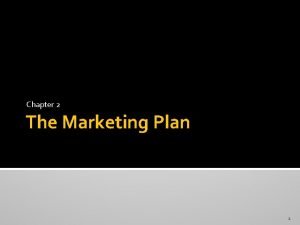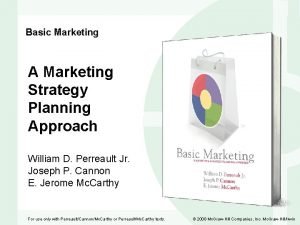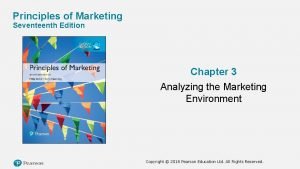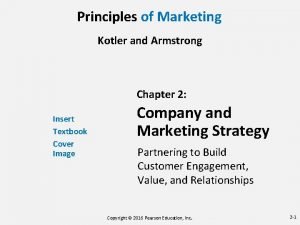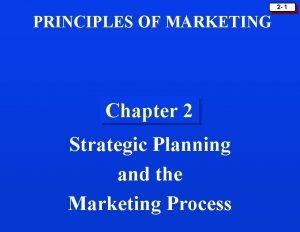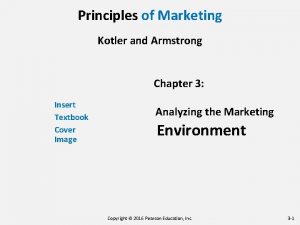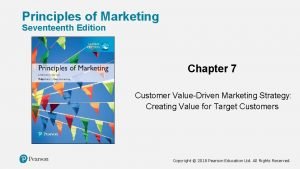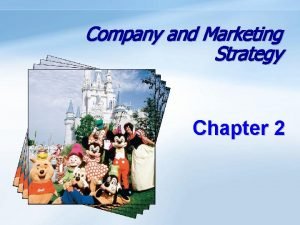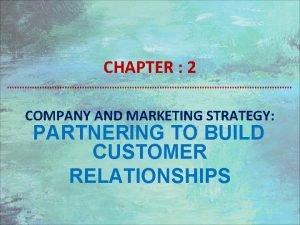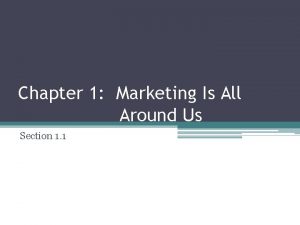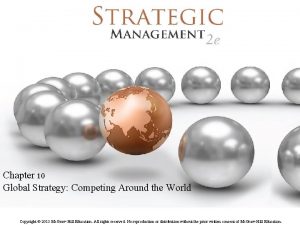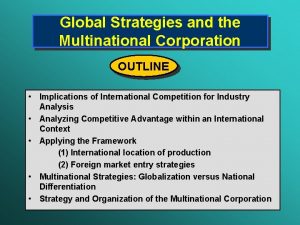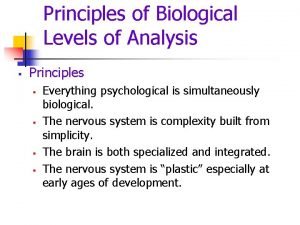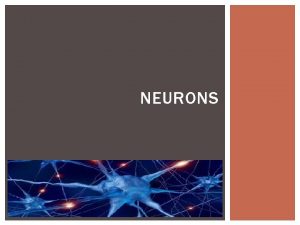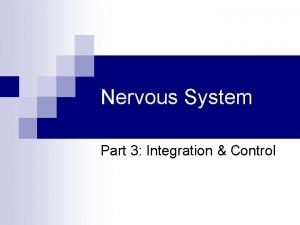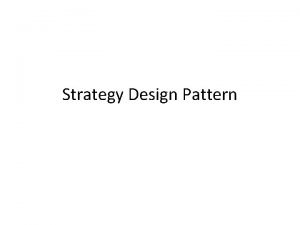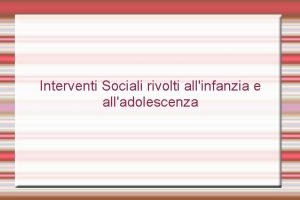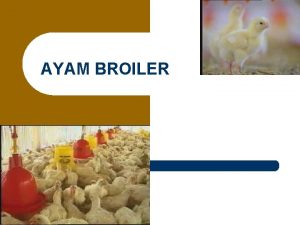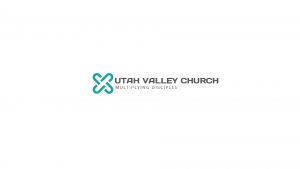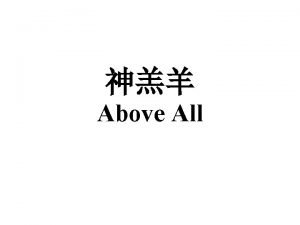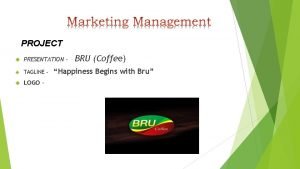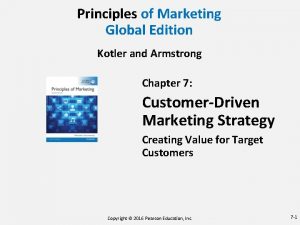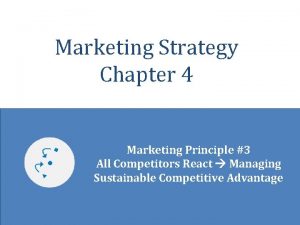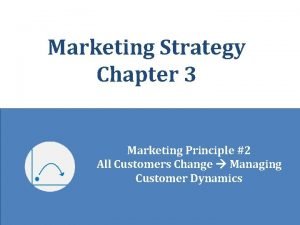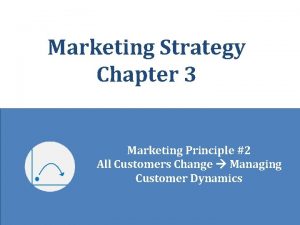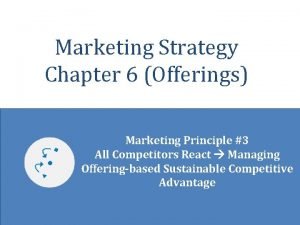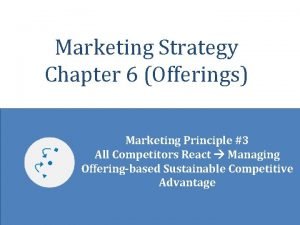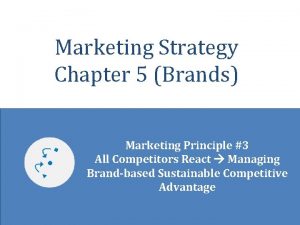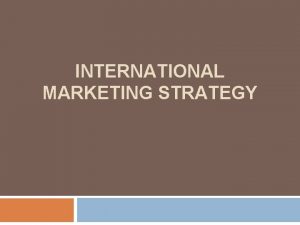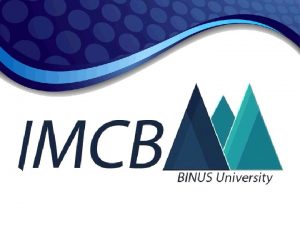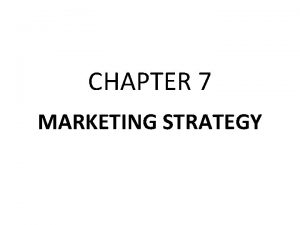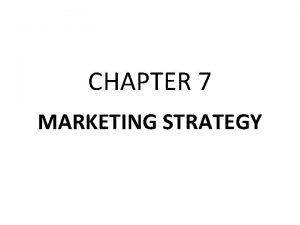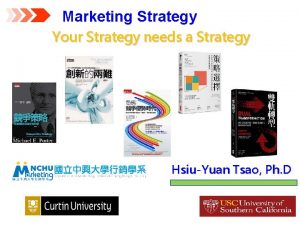Marketing Strategy Chapter 4 Marketing Principle 3 All
















































- Slides: 48

Marketing Strategy Chapter 4 Marketing Principle #3 All Competitors React Managing Sustainable Competitive Advantage © Palmatier 1

Agenda n Introduction n Approaches for Managing Sustainable Competitive Advantage n Evolution of Sustainable Competitive Advantage in Marketing Customer Equity Perspective Customer Experiments Framework for Managing Competitive Advantage Inputs to the Sustainable Competitive Advantage Framework Outputs of the Sustainable Competitive Advantage Framework Process for Managing Sustainable Competitive Advantage n Takeaways n Case © Palmatier 2

All Competitors React n The persistent efforts by all firms in the market to copy and innovate, such that all competitors react, constitutes a third challenge that managers confront n Thus, when managers develop their marketing strategies, they need to consider customers heterogeneity and dynamism, but also anticipate competitors’ reactions, now and in the future, to be able to build barriers that hold up against sustained competitive assaults, termed sustainable competitive advantages (SCA) n Typically a firm must establish the sustainable position with a targeted customer group before they can build an SCA around that position n Of the four First Principles of marketing, managing SCA may be the most difficult to execute © Palmatier 3

Building SCAs is Key Since “All Competitors React” “The art of war teaches us to rely not on the likelihood of the enemy’s not coming, but on our own readiness to receive him; not on the chance of his not attacking, but rather on the fact that we have made our position unassailable. ” Sun Tzu © Palmatier 4

Example: Tesco (UK) n UK grocery giant, world’s third largest retailer n Expanded to other markets, including US, but failed to build an SCA that worked in those markets n Introduced large stores with massive assortments, but many US consumers prefer to visit several stores that offer smaller (but deeper) assortments n Overestimated consumers’ preferences for local brands n Exited the US in 2013 © Palmatier 5

Sustainable Competitive Advantages (SCA) n A firm has an SCA when it is able to generate more customer value than competitive firms in its industry for the same set of products and service categories and when these other firms are unable to duplicate its effective strategy n A good SCA meets three criteria: 1. Customers care about what this SCA offers 2. The firm does it better than competitors, which generates a relative advantage 3. The SCA must be hard to duplicate or substitute, even with significant resources n Thus, being first to market with a new idea is not sufficient to create a barrier to competitors, especially if deep-pocketed market leaders recognize threat of an innovative new entrant and devote their resources to protect their sales to existing customers n To make an SCA hard to copy, firms often turn to key market-based sources of SCAs © Palmatier 6 6

Marketing-Based Sources of Sustainable Competitive Advantage n There are three market-based sources of sustainable competitive advantage n Brands – is most effective in large consumer markets n More effective for consumer goods n Advertising, PR, sponsors Offerings – effective because new and innovative products and services have the potential to disrupt virtually any market segment n R&D n New products and services n New technologies Relationships – most effective in business-to-business, service, and complex offering settings n More effective for B 2 B goods, services, intangibles, and complex or risky offerings n Salespeople, any boundary spanner, online relationships These three sources of sustainable competitive advantage—brands, offerings, and relationships (BOR)—are additive and often work synergistically to give a firm a strong relative position in the marketplace © Palmatier 7

Example: Starbucks (US) n Starbucks has a high-quality brand (valued at $5. 4 billion) that customers feel emotionally attached to n Distinctive offering of unique coffee-based drinks and store environments n Customers develop relationships with the employees in their local stores, who remember their drink orders or recognize them by name n These sources of SCAs, generated from effective BOR strategies, work together to increase customers’ loyalty, and competitors find it very hard to overcome these barriers. n Starbucks continues to innovate its offerings (e. g. , Teavana tea products) and technology-based services (e. g. , mobile payment) to maintain its SCA in this category © Palmatier 8

Example: Maruti (India) n Maruti (now Maruti-Suzuki) led India’s domestic automobile market for nearly 30 years, largely because of laws that limited the entry of foreign firms n With a liberalized market, new players such as Volkswagen and Ford have increased the competitive pressure on Maruti, which thus far has proven unable to reinvent itself to serve India’s younger, more affluent middle class © Palmatier 9

Market-based Sources of SCAs Source Barriers to Duplication Where it is Most Effective Examples Brand images reside in Large consumer markets BMW, Anheuserconsumers' minds, which (soft drinks, beer, fashion, Busch makes them difficult to automobiles) duplicate; facilitates habitual buying through awareness and provides identity benefits to customers Offerings Cost benefits, performance advantages, access to distribution channels Relationships Leads to trust, commitment, and interpersonal reciprocal bonds that are hard to build or duplicate © Palmatier Most markets, technology- Apple i. Phone, Bose, based businesses Tesla (software, electronics) Business-to-business Edward Jones, markets, services, complex Granger products (test equipment, haircut, financial services) 10

In Class Exercise on SCA n Take a few minutes to describe 3 purchases n Bought for brand ________ n n n Top two reasons why _____ & ______ What would it take for you to change ________ Bought for offering ________ Top two reasons why _____ & ______ What would it take for you to change ________ Bought for relationship ________ Top two reasons why _____ & ______ What would it take for you to change ________ If it takes a lot for you to change then firm has built a strong SCA © Palmatier 11 11

Competitive Reaction: A Fundamental Assumption of Marketing Strategy n n Competitors can displace firms in many different ways, including: 1. Technical innovations that provide competitors with a platform to launch a disruptive offering 2. Exploiting changes in customers’ desires due to cultural, environmental, or other factors 3. Individual entrepreneurship that constantly seeks a better way to solve a problem 4. “Me-too” copycats that improve the efficiency or effectiveness of an existing execution Thus, managers need to anticipate competitors’ reactions, now and in the future, by building barriers or sustainable competitive advantages that can withstand competitive assaults Marketing Principle #3: all competitors react and an effective marketing strategy must manager the firm’s sustainable competitive advantage (SCA) © Palmatier 12

Agenda n Introduction n Approaches for Managing Sustainable Competitive Advantage n Evolution of Sustainable Competitive Advantage in Marketing Customer Equity Perspective Customer Experiments Framework for Managing Competitive Advantage Inputs to the Sustainable Competitive Advantage Framework Outputs of the Sustainable Competitive Advantage Framework Process for Managing Sustainable Competitive Advantage n Takeaways n Case © Palmatier 13

Evolution of Approaches for Managing Sustainable Competitive Advantage in Marketing 1 Pre-Industrial Age Interpersonal relationships are the greatest barrier to competitive attacks Industrial Revolution Technology Revolution Brands are important to signal product quality Offerings and innovations become key sources of differentiation Sources of SCA Services Revolution All three BOR strategies are critical to success, but relationships are becoming more important with the shift to a service economy in more developed countries (85% of U. S. GNP) Relationships Brands Offerings Factors Affecting the Sources of SCAs • Producer is both the marketer and the retailer. • Sales are to geographically proximate customers. • Examples: Shoe cobblers, farmers, and tailors all relied on direct relationships with customers; traders on the silk route relied on relational trust with other traders to exchange goods. © Palmatier • Mass production provides • economies of scale. • More geographically dispersed customers. • • Emergence of middlemen. • Large supply creates the need for • aggressive sales promotions. • Examples: Original brands built on strong family names such as Ferrari, J. C. Penney, and Gillette to signal quality and differentiate themselves from competitors. Shift from tangible to digital and knowledge products. Fast technological change and turbulence. Examples: Apple and Google who both focus on technological innovation and have surpassed Coca-Cola as the most valuable brands. • Disintermediation removes the middleman between producer and consumer. • Economy shift from a focus on products to services. • Examples: IBM shifted to selling business solutions rather than equipment; financial service firms such as HSBC and Wells Fargo continue to grow. 14

Evolution of Sustainable Competitive Advantage in Marketing n Pre-Industrial Age – interpersonal relationships were the greatest barrier to competitive attacks n Industrial Revolution – brands are important to signal product quality n Technology Revolution – offerings and innovations become key sources of differentiation n Services Revolution – all three BOR strategies are critical to success, but relationships are becoming more important with the shift to a service economy in more developed countries n Some researchers argue that developed counties are undergoing the next SCA revolution, due to the wider shift to a service economy Despite the shifting emphases on the different sources of SCA, all three sources (brands, offerings, and relationships) build on one another and often combine synergistically to determine a firm’s overall SCA © Palmatier 15

Customer Equity Perspective n Customer equity for a firm refers to “the total of the discounted lifetime values of all its customers” n When a firm advertises to build strong brands, makes R&D investments to develop innovative products, or spends to hire and train salespeople who can enter into relationships with clients, it should increase that firm’s brand, offering, and relational equities n Together these three BOR equities constitute the firm’s customer equity and often is the best barrier (SCA) to competitive assault, sometimes termed a BOR Equity Stack © Palmatier 16

“Customer Equity” a Different Measure of a Firm’s Most Important Assets n Premise: Customers are considered a financial asset, which should be measured, managed, and maximized Treat customers just like other assets even though accountants typically don’t treat “customers” as an asset Customer equity is not captured on a balance sheet: spending on building equity (e. g. , brands, R&D, relationships) is treated as an expense n Why bother with customer-centric accounting: 1. Primary driver of many firms’ sales and profits 2. 3. © Palmatier Brand, offering, and relational equities are a primary source of firm’s SCA Captures long-term impact of marketing actions (Coke’s brand equity reaches past one year) 17 17

BOR Equity Stack n Three equities combine in an additive customer or BOR equity stack 1. Relationship equity 2. Brand equity 3. Offering equity n At the individual level, customer equity is analogous to the customer’s lifetime value (CLV) n Then when each customer’s equity is added together, it generates the firm’s overall customer equity n In this sense, the customer equity perspective is well suited to using a CLV analysis approach, because each market-based equity can be assessed as an addition to the customer’s discounted cash flow over time n Thus, BOR equities are similar to tangible assets: They generate a return on assets (ROA), can be built through investments, and depreciate over time if not maintained © Palmatier 18

Customer Equity Perspective: Brand, Offering, Relationship Equity Stack Total value to customer © Palmatier Customer/BOR Equity Stack Beer Example Relationship Equity A set of relational assets and liabilities linked to boundary-spanning employees and the social network associated with the offering or experience that add to or subtract from the value provided by a firm’s offering Relationship Equity The difference between the price a customer would pay for a glass of a branded beer and having the same beer served by his or her favorite bartender Brand Equity A set of brand assets and liabilities linked to a brand, its name, and symbols that add to or subtract from the value provided by a firm’s offering Brand Equity The difference between the price a customer would pay for an unlabeled glass of beer and the same beer after learning the brand Offering Equity The core benefits relative to costs of an offering, stripped of brands or relationships Offering Equity How much customers would pay for an unlabeled glass of beer (e. g. , blind taste test) 19

Offering Equity (Beer) n Offering equity represents the core benefits relative to costs of an offering stripped of any benefits from brands or relationships Price and performance only Represents a large portion of total equity for commodity products (e. g. , EDLP strategies) Does Wal-Mart have much brand or relationship equity? n Less important for: Services or high involvement products Products that provide meaning or status Maturing markets/industries © Palmatier 20 20

Brand Equity (Beer name/label/image) n Brand equity is a set of brand assets and liabilities linked to a brand, its name, and symbol, that add to or subtract from the value provided by a firm’s offering Knowledge of the brand differentially affects behavior Brand equity “lies in the minds of the customer” n Key for consumer goods, status based offerings, and as consumption is more visible n Since brand building can be hard to target, brand equity is better for offerings with large homogenous user group n Hard to quickly adapt or change brand equity Keller (2008) © Palmatier 21 21

Relationship Equity (people serving beer and other customers) n Relationship equity is a set of relational assets and liabilities linked to boundary spanning employees and the social network associated with the offering or experience that add to or subtract from the value provided by a firm’s offering n Relationships affect behavior Relational-based decision making is ingrained in our psyche (20 to 30% of brain) Many psychological processes are engaged in relational or pseudo-relational contexts n Key for B 2 B, services, and complex selling cycles n Can target and adapt more easily than brands Keller (2008) © Palmatier 22 22

Using Experiments to Determine Customer Equity n Strong test of causality since: Random assignment of customers Control of conditions or treatments Comparison to control groups overtime n Use to test “findings” from other method n Simple process 1. Randomly divide customers into groups (2 to 3) 2. Do nothing to one group (control group) 3. Do your test (conditions/treatments) to other group(s), but nothing else (ideally customers and employees involved don’t know the difference; “double blind”) 4. After period of time test the difference in outcomes across groups and see if it varied significantly © Palmatier 23 23

DAT 4. 1 Marketing Experiments Description Marketing experiments test how customers might respond to marketing decisions, while ruling out confounds that otherwise would be present when comparing a treatment to a control group. How it Works © Palmatier When to Use • To determine if there is a direct causal relationship between a specific BOR (brand/offering/relational) investment and customer or firm outcomes. • To choose among a set of BOR investment strategies and tactics, according to their financial impacts (e. g. , lift in sales).

DAT 4. 1 Example Objective © Palmatier Marketing Experiments When to Us

Example: Find Best Internet “Ad” n n You want to get people to buy supplemental items when buying online plane tickets You have existing ad Your boss wants to use a new swim suit ad Take 5 minutes and design your experimental test to make the decision Discuss: Sample source and size Research design Analysis of data Address bias concerns: time of year, day, weather, other print ads running, other © Palmatier 26 26

Results of Experiment (Using Excel) n Randomly assign customers n Analysis n © Palmatier Mean Median Std. dev. Difference in groups T-test to determine if difference in means is significant Excel does all of this 27 27

Natural Experiments (Data Mining) n Not as a strong test of causality, but often only choice n Use natural variation or shock to business n Example: Competitor entered three markets and your sales force has responded differently (matched price, held price, gave free shipping). Use differences in effect on sales to see what is best strategy But, what if territories are not the same (size, brand strength, types of products sold)? You can do the same test while “controlling” for these other variables (comparing means or regression) Strategies may work better for some customers than others (segment and test) © Palmatier 28 28

Customer Equity Perspective Offers Many Benefits But It Is Hard to Do n Customer equity perspective involves building and maintaining a parallel “customer-centric accounting process, ” outside the firm’s normal financial accounting process n There are three main arguments for using customer equity accounting and a BOR equity stack 1. BOR equities are often the primary source of a firm’s SCA 2. To make optimal decisions, a firm needs a framework that measures, tracks, and reports customer equities 3. Effective customer equity systems represent a SCA in their own right n Suboptimal marketing decisions happen in firms every day, at many different management levels, and especially during economic downturns n Many firms’ primary SCA result from their BOR investments and strategies, but other sources of SCA are available too, including deep and low cost financial resources, human resource strategies, and operational processes © Palmatier These aspects fall outside of the scope of a marketing strategy, so the framework we present in the next section focuses instead on implementing a customer equity perspective using a BOR equity stack 29

Agenda n Introduction n Approaches for Managing Sustainable Competitive Advantage n Evolution of Sustainable Competitive Advantage in Marketing Customer Equity Perspective Customer Experiments Framework for Managing Competitive Advantage Inputs to the Sustainable Competitive Advantage Framework Outputs of the Sustainable Competitive Advantage Framework Process for Managing Sustainable Competitive Advantage n Takeaways n Case © Palmatier 30

Framework for Managing Sustainable Competitive Advantage n The organizing framework for managing sustainable competitive advantages (SCA) integrates the preceding approaches and analyses n Three key inputs: 1. 2. 3. Positioning statements AER strategies Future trends n Two outputs: 1. 2. © Palmatier SCAs BOR strategies 31

Marketing Principle #3: All Competitors React Managing Sustainable Competitive Advantage Inputs (MP#1 & MP#2) Managing Sustainable Competitive Advantage SCAs Positioning Statements • Target (external customers) • AER (internal personas) AER Strategies • What strategies work best for each persona/AER stage Future Trends • Technology trends • Regulatory trends • Socioeconomic trends © Palmatier Outputs (SCA, BOR) Approaches & Processes SCA Brand, offering, relationship equity stack AER strategy and BOR equity grids Brand relationship mgt. Innovation processes • Existing SCAs, why you win now • Future SCAs, how you will win in future Analyses Field experiments Conjoint analysis Multivariate regression Choice models BOR Strategies • Brand strategies • Offering/innovation strategies • Relationship marketing strategies 32

Inputs to the Sustainable Competitive Advantage Framework n Positioning statements – answers three key questions: Who customers are What set of needs the product or service fulfills Why this product/service is the best option to satisfy customer needs (relative to competition) n AER strategies – provide key guidance into how a firm should invest to acquire and keep customers n Future trends – long-term technology, regulatory, and socioeconomic trends, which clearly can disrupt any organization’s SCAs © Palmatier 33

Example: Brussels Airlines (Belgium) n Brussels Airlines, Belgium’s national carrier, emphasizes the importance of adapting its marketing model with the changing technological trends n “We have all got to digitally transform to provide the tools to our guests that can help them get through the whole air travel experience. We need to allow them to book online and do everything they need to do from their mobile devices. ” Simon Lamkin, CIO © Palmatier 34

Outputs of the Sustainable Competitive Advantage Framework n Descriptions of the firm’s SCA now and in the future – needs to clearly address the three conditions for SCA: 2. Customers care about it The firm does it better than competitors 3. It is hard to duplicate or substitute 1. n Detailed BOR strategies – aggregate and reorganize each targeted customer segment and persona according to its needs; the most effective strategies across time (accounting for customer dynamics) are in the brand, offering, and relationship categories n Both these outputs (SCA and BOR strategies) represent aggregations of insights gained from more fine-grained analyses, combined and reorganized to support effective macro-level decision making © Palmatier 35

Process for Managing Sustainable Competitive Advantage n Step 1: AER Strategy Grid – each box in this grid describes the most effective strategy for a unique persona at a single point in time n Step 2: Key Trends – managers should account for key environmental trends (e. g. , long-term technology or regulatory changes) so that investments in BOR strategies lead to SCA, now and later n Step 3: BOR Equity Grid – completed to describe three key pieces of information for the BOR strategies Marketing objectives Relative advantages Sources of sustainability © Palmatier 36

Natural Sequence for Using Brands, Offerings, and Relationships to Build an SCA 1. A firm should make brand decisions, which are influenced by the firm’s overall positioning objectives from MP#1 and MP#2 and largely determine how the firm will be positioned in the overall marketplace and in existing customers’ minds 2. The firm can then focus on its offering decisions; product and service innovation and R&D efforts need to support both brand strategies and the firms positioning objectives 3. Relationship strategies normally are determined last, because they involved the delivery and experiential aspect because in this case, boundary spanners are critical to the customer experience and the firm’s overall value proposition © Palmatier 37

Connections Between AER Strategy and BOR Equity Grids AER Strategy Grid Acquisition Strategy Expansion Strategy Retention Strategy Persona #1 Most effective acquisition strategies for Persona 1 Most effective expansion strategies for Persona 1 Most effective retention strategies for Persona 1 Persona #2 Most effective acquisition strategies for Persona 2 Most effective expansion strategies for Persona 2 Most effective retention strategies for Persona 2 Most effective acquisition strategies for Persona 3 Most effective expansion strategies for Persona 3 Most effective retention strategies for Persona 3 Persona #3 Personas account for customer heterogeneity AER stages account for customer dynamics BOR Equity Grid Marketing Objectives Relative Advantages Sources of Sustainability Brand Strategy (Chapter 5) Brand marketing objectives Relative advantages of the firm’s brand vs. competitors’ brands Brand’s sources of sustainability Offering Strategy (Chapter 6) Offering and innovation objectives Relative advantages of the firm’s offering vs. competitors’ offerings Offering’s sources of sustainability Relationship Strategy (Chapter 7) Relationship marketing objectives Relative advantages of the firm’s relationships vs. competitors’ relationships Relationship marketing’s sources of sustainability Environmental Trends Technology trends Regulatory trends Socioeconomic trends © Palmatier 38

AER Strategy Grid: Micro-Analysis of Customer Heterogeneity and Dynamics n Output of MP#2 is a microanalysis of customer heterogeneity and dynamics in the firm’s customer portfolio n The insights from MP#2 then can be inserted into the AER strategy grid to reveal highimpact strategies n Each box in this grid describes the most effective strategy for a unique persona at a single point in time AER Strategy Grid Acquisition Strategy Expansion Strategy Retention Strategy Persona #1 Most effective acquisition strategies for Persona 1 Most effective expansion strategies for Persona 1 Most effective retention strategies for Persona 1 Persona #2 Most effective acquisition strategies for Persona 2 Most effective expansion strategies for Persona 2 Most effective retention strategies for Persona 2 Persona #3 Most effective acquisition strategies for Persona 3 Most effective expansion strategies for Persona 3 Most effective retention strategies for Persona 3 © Palmatier 39

BOR Equity Grid: Macro-Perspective of Market-Based Sources of SCA n Brand, Offering, and Relationship (BOR) Equity Grid represents last step in the process n BOR equity grid offers a high-level summary of what the firm is trying to achieve with each BOR strategy n Using the inputs from the AER strategy grid and key environmental trends, the BOR equity grid can be completed to describe three key pieces of information for the BOR strategies: BOR Equity Grid Marketing Objectives Relative Advantages Sources of Sustainability Brand Strategy (Chapter 5) Brand marketing objectives Relative advantages of the firm’s brand vs. competitors’ brands Brand’s sources of sustainability Offering Strategy (Chapter 6) Offering and innovation objectives Relative advantages of the firm’s offering vs. competitors’ offerings Offering’s sources of sustainability Relationship marketing objectives Relative advantages of the firm’s relationships vs. competitors’ relationships Relationship marketing’s sources of sustainability Relationship Strategy (Chapter 7) © Palmatier Marketing objectives Relative advantages over competition Maintaining the SCA over time 40

Agenda n Introduction n Approaches for Managing Sustainable Competitive Advantage n Evolution of Sustainable Competitive Advantage in Marketing Customer Equity Perspective Customer Experiments Framework for Managing Competitive Advantage Inputs to the Sustainable Competitive Advantage Framework Outputs of the Sustainable Competitive Advantage Framework Process for Managing Sustainable Competitive Advantage n Takeaways n Case © Palmatier 41

Takeaways n All competitors react. Firms must address competitive attacks by building and maintaining sustainable competitive advantages (SCA). n Customers generate sales and profits; firms must protect them from constant attacks by competitors. Although SCA are critical, firms must first establish their differentiated position with a targeted customer group before building SCA around this position. n All SCA must meet three conditions: (1) customers must care about what it offers, (2) the firm must do it better than competitors, and (3) it must be hard to duplicate. n In marketing domains, the primary sources of SCA are brands, offerings (innovative products or services), and relationships (BOR). The strongest SCA use all three strategies in combination to reinforce the differentiated and targeted appeal of a firm to customers. © Palmatier 42

Takeaways n Experiments can reveal the causality of BOR investments, by randomly assigning customers to multiple groups with different BOR investment levels/designs, including both treatment and control groups, to minimize potential confounds. n Competitors have many ways to undermine a firm’s SCA, including technical innovations, exploiting customers’ changed desires, finding better solutions to a problem, and introducing “me-too” offerings with greater efficiency. n A customer equity perspective implies that customers should be considered assets, managed and tracked that way, to improve firm performance. Investments in brands, offerings, and relationships represent important sources of customer equity. n There are three inputs to the SCA framework: the output of MP#1 about what customers want and how the firm should position itself, the output of MP#2 about the most effective AER strategies as customers change, and long-term environmental trends. © Palmatier 43

Takeaways n The two outputs of the SCA framework are: a description of a firm’s SCA now and in the future and a description of the BOR strategies needed to achieve it. n The three-step process for managing SCA includes an AER Strategy Grid, an analysis of key environmental trends, and a BOR Equity Grid. n Technology, regulatory, and socioeconomic trends constantly change; a firm’s competitors constantly try to find new ways to satisfy customers’ needs and desires. These changes all have the potential to disrupt any firm’s market position. © Palmatier 44

Readings n Step-by-Step Guide to Smart Business Experiments (short non-technical review of using experiments in business with some good examples) n Marketing Strategy Book: Chapter 4 © Palmatier 45

Agenda n Introduction n Approaches for Managing Sustainable Competitive Advantage n Evolution of Sustainable Competitive Advantage in Marketing Customer Equity Perspective Customer Experiments Framework for Managing Competitive Advantage Inputs to the Sustainable Competitive Advantage Framework Outputs of the Sustainable Competitive Advantage Framework Process for Managing Sustainable Competitive Advantage n Takeaways n Case © Palmatier 46

Analytics Driven Case: Fighting Competitive Attack at Exteriors Inc. n n Background: Exteriors Incorporated (EINC) is US leading manufacturer of roofing shingles Elite player in the market – high prices and high quality Losing market share to low priced competitors after 2008 recession Problem: ENIC needs to build sustainable competitive advantage (SCA) n What is the right mix of brand, offering, and relationship equity? Data: Survey: importance of the four key attributes: price, life expectancy, aesthetics, and speed of installation all were rated as important by customers Conjoint model: understanding the importance of the trade-offs among the attributes relative importance of 9 product bundles Willingness to pay model: using part-worth utilities from conjoint model © Palmatier 47

Analytics Driven Case: Fighting Competitive Attack at Exteriors Inc. n n Results: Products with high life expectancy, delivered within a week were rated the best Aesthetics did not matter as much as EINC thought they would Price part-worths were not as large as the life expectancy and speed of installation attributes consumers not as sensitive to price as other product attributes Actions: Maintaining higher price Develop product with high life expectancy and quick installation © Palmatier 48
 Name
Name Using a single marketing strategy to reach all customers.
Using a single marketing strategy to reach all customers. Universal functions of marketing
Universal functions of marketing Chapter 3 marketing
Chapter 3 marketing Principle of marketing chapter 5
Principle of marketing chapter 5 Marketing plan kotler
Marketing plan kotler Principles of marketing chapter 2
Principles of marketing chapter 2 Chapter 3 marketing
Chapter 3 marketing Chapter 7 customer driven marketing strategy
Chapter 7 customer driven marketing strategy Company and marketing strategy chapter 2
Company and marketing strategy chapter 2 Chapter 2 company and marketing strategy
Chapter 2 company and marketing strategy Marketing is all around
Marketing is all around Marketing is all around us
Marketing is all around us Business strategy vs corporate strategy
Business strategy vs corporate strategy Global matrix structure
Global matrix structure Chase aggregate plan example
Chase aggregate plan example Multidomestic corporation
Multidomestic corporation Aligning hr strategy with business strategy
Aligning hr strategy with business strategy Global strategy
Global strategy Crafting and executing strategy in strategic management
Crafting and executing strategy in strategic management Strategy formation
Strategy formation Recognizing cognates top down or bottom up
Recognizing cognates top down or bottom up Corporate strategy growth stability retrenchment
Corporate strategy growth stability retrenchment Multinational strategy vs global strategy
Multinational strategy vs global strategy Refractory period
Refractory period Neuron label quiz
Neuron label quiz Is atp needed for muscle contraction
Is atp needed for muscle contraction Cerebeluum
Cerebeluum What is all or none principle
What is all or none principle Strategic design pattern in java
Strategic design pattern in java Help ever hurt never meaning in hindi
Help ever hurt never meaning in hindi Interventi sociali rivolti all'infanzia e all'adolescenza
Interventi sociali rivolti all'infanzia e all'adolescenza Like a rose trampled on the ground
Like a rose trampled on the ground I work all night
I work all night All to one reduction
All to one reduction Sistem all in all out
Sistem all in all out Fossa tabatiere
Fossa tabatiere Silent night holy night all is calm all is bright
Silent night holy night all is calm all is bright 馮定華神父
馮定華神父 All of you is more than enough for all of me
All of you is more than enough for all of me John donne born
John donne born No power of death no scheme of man
No power of death no scheme of man Above all powers above all kings
Above all powers above all kings Pricing strategies of starbucks
Pricing strategies of starbucks Nfl swot analysis
Nfl swot analysis Marketing strategy of bru coffee
Marketing strategy of bru coffee Positioning kotler
Positioning kotler Bor strategy marketing
Bor strategy marketing Aer model marketing
Aer model marketing

